Stock Status and Conservation Information
(From ISC24 Plenary Report)
- Albacore
- Pacific Bluefin
- Blue Marlin
- Striped Marlin
- Swordfish
- Blue shark
- Shortfin mako
Pacific Bluefin Tuna
![]() Click here to see the ISC23 stock status and conservation information.
Click here to see the ISC23 stock status and conservation information.
The base-case model results show that: (1) spawning stock biomass (SSB) fluctuated throughout the assessment period (fishing years 1983-2022); (2) the SSB steadily declined from 1996 to 2010; (3) the SSB has rapidly increased since 2011; (4) fishing mortality (F%SPR) decreased from a level producing about 1% of in 2004-2009 to a level producing 23.6% of SPR in 2020-2022; and (5) SSB in 2022 increased to 23.2% of , achieving the second rebuilding target by WCPFC and IATTC in 2021. Based on the model diagnostics, the estimated biomass trend throughout the assessment period is considered robust. The SSB in 2022 was estimated to be 144,483 t (Table 1 and Figure 1), more than 10 times of its historical low in 2010. An increase in immature fish (0-3 years old) is observed in 2016-2019 (Figure 2), likely resulting from reduced fishing mortality on this age group. This led to a substantial increase in SSB after 2019. The method to estimate confidence interval was changed from bootstrapping in the previous assessments to normal approximation of the Hessian matrix.
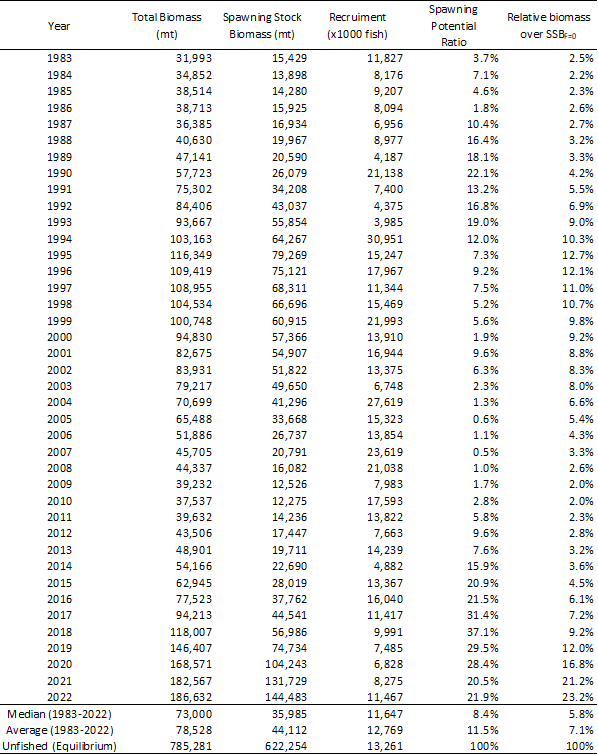
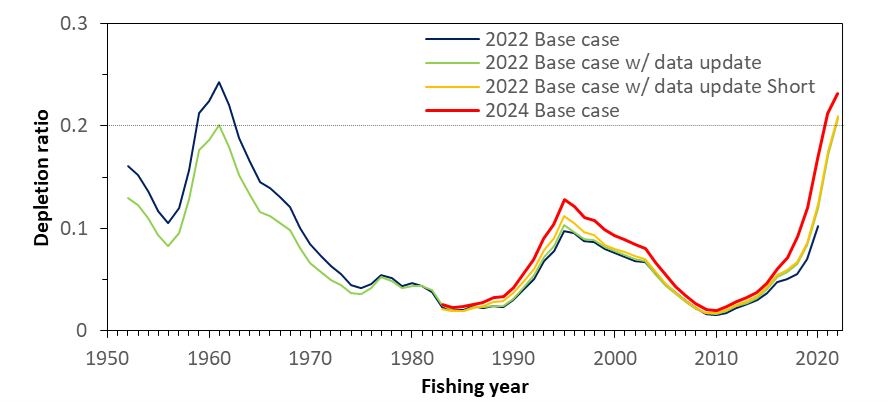
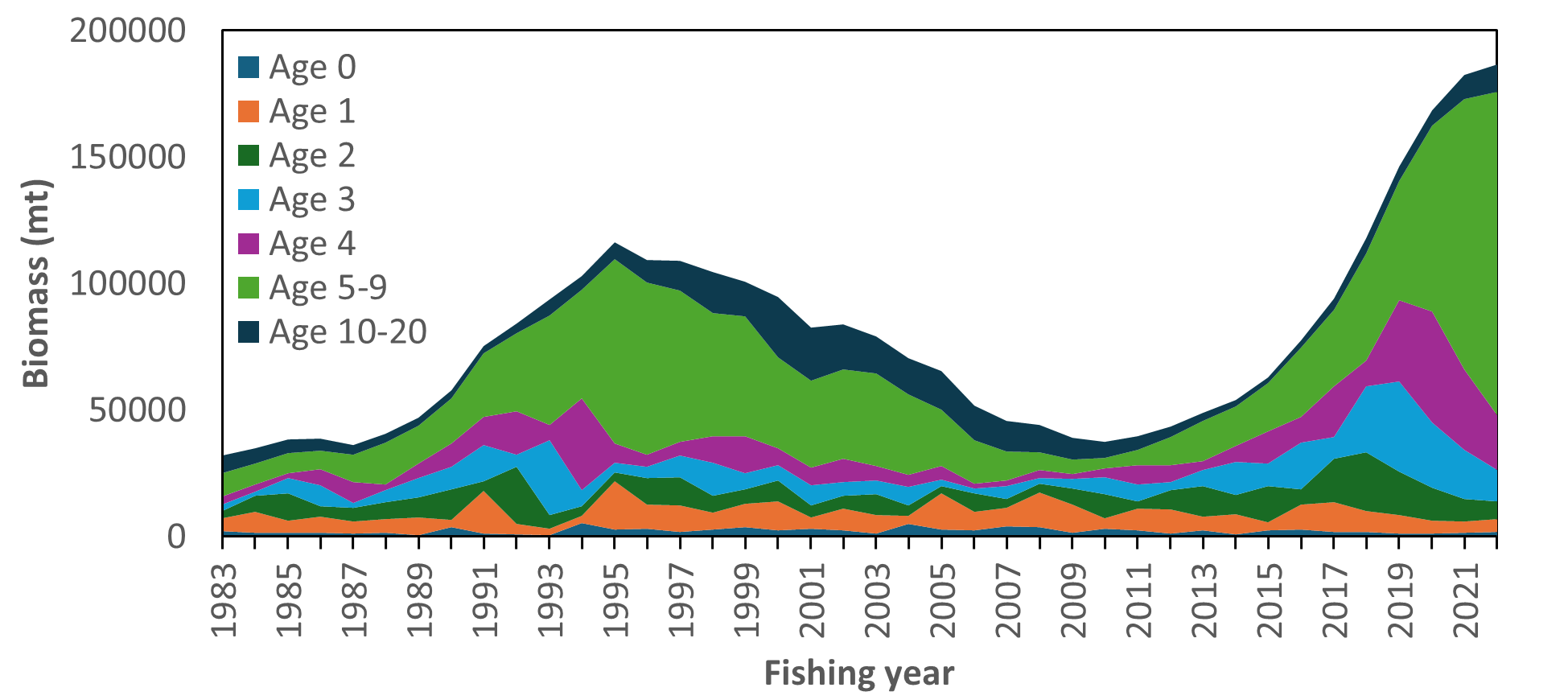
Historical recruitment estimates have fluctuated since 1983 without an apparent trend (Figure 3). Stock projections assume that future recruitment will fluctuate around the historical (1983-2020 FY) average recruitment level. Previously, no significant autocorrelation was found in recruitment estimates, supporting the use of randomly resampled recruitment from the historical time series. In addition, now that SSB has recovered to 23.2%SSBF=0, the PBFWG considers the assumption that the future recruitment will fluctuate within the historical range to be reasonable. The PBFWG also confirmed that the distributions of historical recruitment from the updated long-term model (1952-2022) and the present base-case model (1983-2022) are comparable.
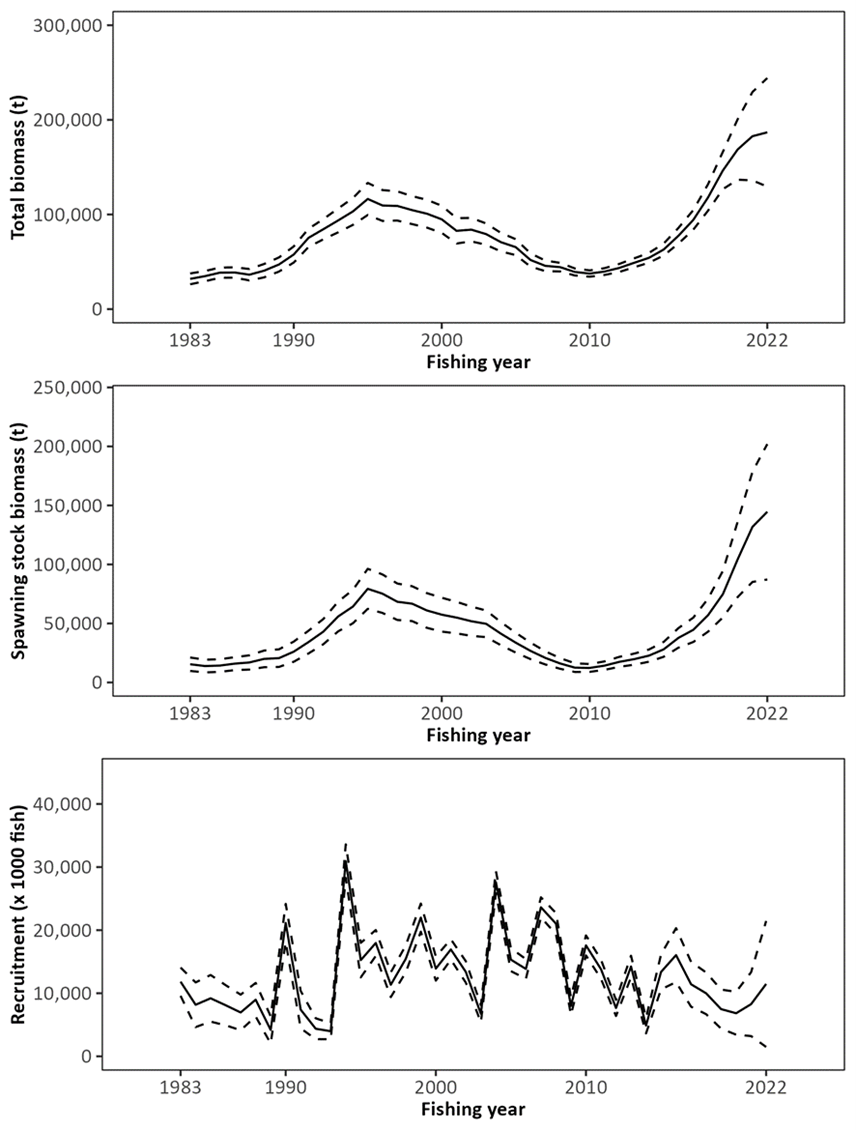
Stock Status
PBF spawning stock biomass (SSB) has increased substantially in the last 12 years. These biomass increases coincide with a decline in fishing mortality, particularly for fish aged 0 to 3, over the last decade. The latest (2022) SSB is estimated to be 23.2% of SSBF=0 and the probability that it is above 20%SSBF=0 is 75.9%.
- Based on these findings, the following information on the status of the PBF stock is provided by the ISC24 Plenary:
- No biomass-based limit or target reference points have been adopted for PBF, but the PBF stock is not overfished relative to 20%SSBF=0, which has been adopted as a biomass-based reference point for some other tuna species by the IATTC and WCPFC. SSB of PBF reached its initial rebuilding target (SSBMED = 6.3%SSBF=0) in 2017, seven years earlier than originally anticipated by the RFMOs, and its second rebuilding target (20%SSBF=0) in 2021; and
- No fishing mortality-based reference points have been adopted for PBF by the IATTC and WCPFC. The recent (2020-2022) F%SPR is estimated to be 23.6% and thus the PBF stock is not subject to overfishing relative to some of F-based reference points proposed for tuna species (Table 2), including F20%SPR.

Conservation Information
After the steady decline in SSB from 1996 to the historically low level in 2010, the PBF stock has started recovering, and recovery has been more rapid in recent years, coinciding with the implementation of stringent management measures. The 2022 SSB was 10 times higher than the historical low and is above the second rebuilding target adopted by the WCPFC and IATTC, which was achieved in 2021. The stock has recovered at a faster rate than anticipated when the Harvest Strategy to foster rebuilding (WCPFC HS 2017-02) was implemented in 2014. The fishing mortality (F%SPR) in 2020-2022 is at a level producing 23.6%SPR. According to the requests from WCPFC and IATTC, future projections under various scenarios were conducted. The projection scenarios and their results, including projected yield are shown in Tables 3, 4, and 5 and Figure 4. In addition, the results of additional projections which were requested by the IATTC-WCPFC NC JWG are provided in Appendix 2 of the stock assessment report (ISC/24/ANNEX/13).
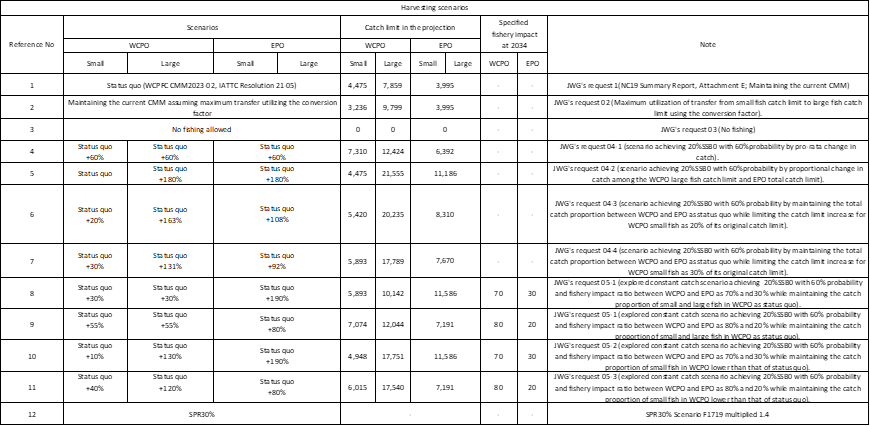
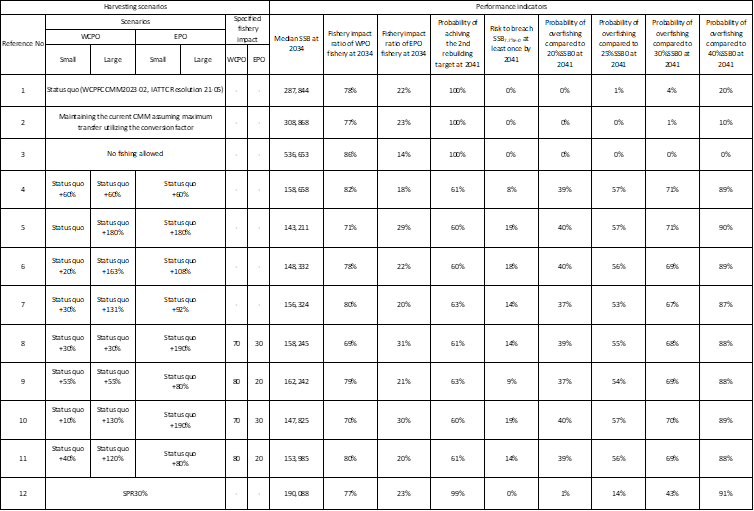
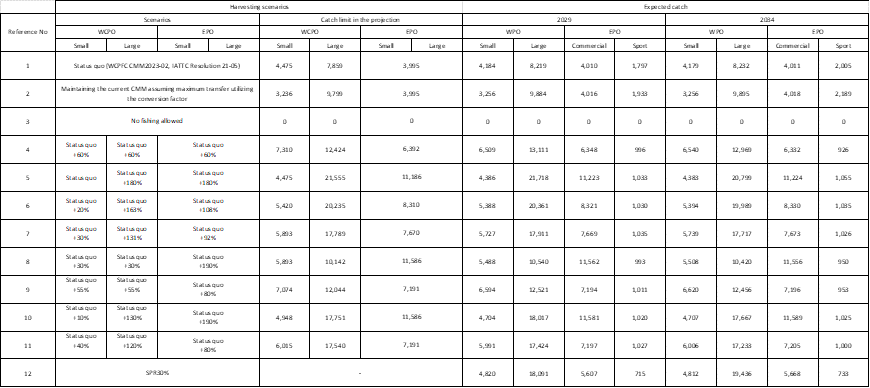
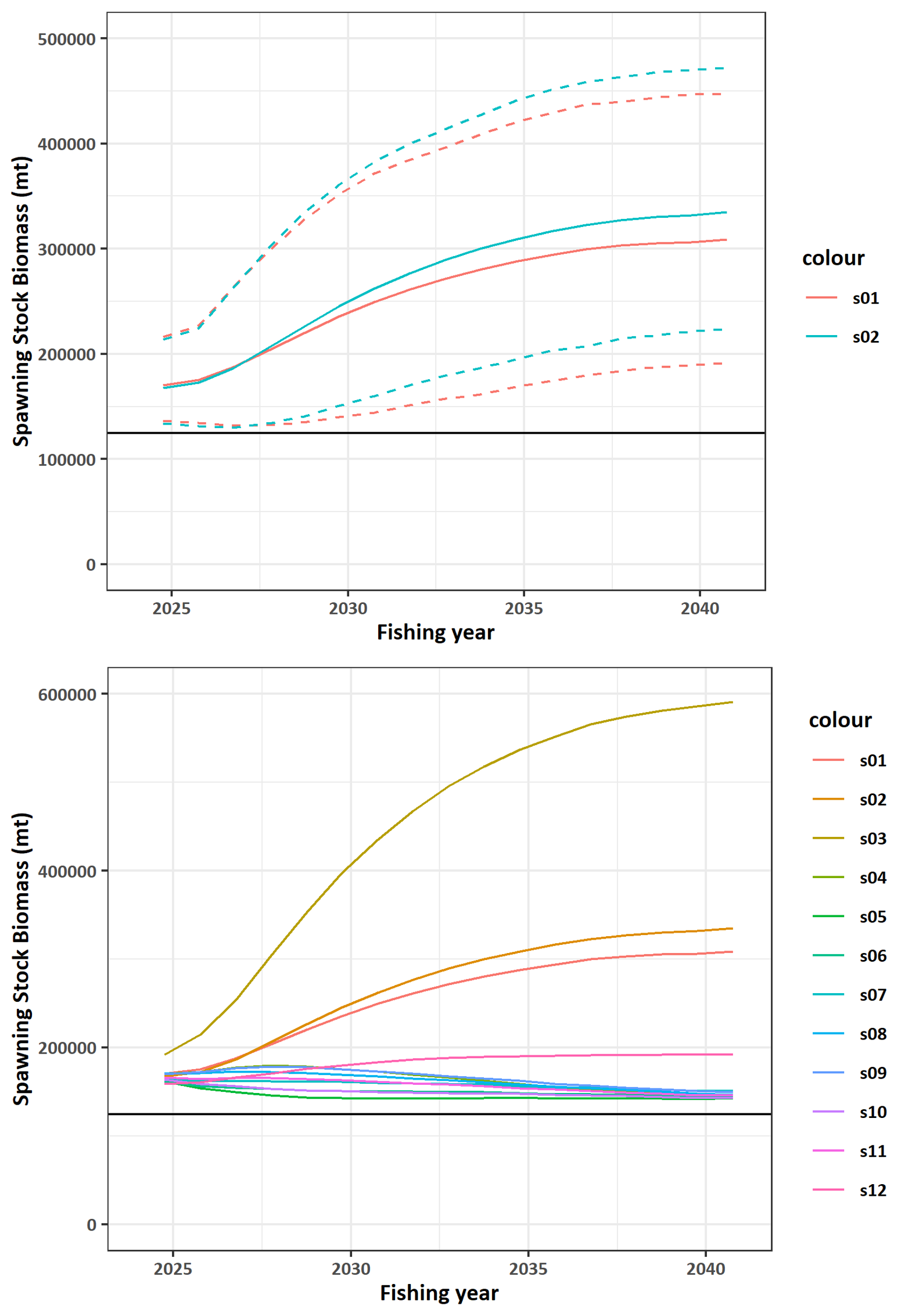
Based on these findings, the following information on the conservation of the PBF stock is provided by the ISC24 Plenary:
- The PBF stock is recovering from the historically low biomass in 2010 and has exceeded the second rebuilding target (20%SSBF=0). The risk of SSB falling below 7.7%SSBF=0 (interim LRP for tropical tunas in IATTC) at least once in 10 years is negligible;
- The projection results show that increases in catches are possible. However, the risk of falling below the second rebuilding target will increase with larger increases in catch;
- The projection results assume that the CMMs are fully implemented and are based on certain biological and other assumptions. For example, these future projection results do not contain assumptions about discard mortality. Discard mortality may need to be considered as part of future increases in catch; and
- Given the uncertainty in future recruitment and the influence of recruitment on stock biomass as well as the impact of changes in fishing operations due to the management, monitoring recruitment and SSB should continue. Research on a recruitment index for the stock assessment should be pursued, and maintenance of a reliable adult abundance index should be ensured. In addition, accurate catch information is the foundation of good stock assessment.